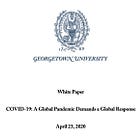In examining the COVID-19 pandemic through the lens of systems analysis, a disturbing possibility appears: the virus itself may have been largely irrelevant to what was actually accomplished during the pandemic years. What matters is not the pathogen's origin or characteristics, but rather how it served as a tool, eliminating resistance to pre-designed infrastructure that had been waiting — in some cases for decades — for the right moment of implementation.
The fundamental paradox of biological weapons reveals why the virus itself could never have been the primary objective. Any pathogen released into the wild immediately encounters what a systems theorist would consider infinite-complexity-meets-infinite-complexity. Billions of unique immune systems interact with countless environmental conditions, creating evolutionary pressures that no laboratory can predict or control. Each viral replication represents a potential mutation, each transmission a roll of genetic dice. The hubris required to believe one could control evolution itself after release would be matched only by the stupidity of attempting it.
This becomes even more apparent when we consider how modern governance systems actually function. The entire edifice of contemporary global management depends on stable, predictable data flows feeding into computational models. These digital twins, as they're called in the technical literature, require clean inputs to generate policy outputs. A truly dangerous pathogen would produce chaos, not data. Hospital systems would genuinely collapse rather than see staff perform synchronised TikTok dances. Essential workers maintaining the surveillance infrastructure would die at their posts. The carefully calibrated system of indicators and thresholds that triggers automated policy responses would drown in noise.
The Indicator Machine
During COVID-19, we witnessed the first full-scale deployment of indicator-based governance, where human judgment was replaced by functional thresholds. When hospital bed occupancy crossed 85% in a given region, lockdown measures triggered automatically. Politicians didn't realistically decide — the modelled data decided for them. When test positivity rates exceeded predetermined percentages, schools closed without debate. The daily updated R-number determined whether you could visit your dying grandmother or even attend her funeral. ICU capacity percentages dictated whether businesses could operate, regardless of their actual safety measures or economic importance.
This wasn't democracy degraded — it was democracy replaced by dashboard. Wastewater surveillance data from university dormitories could trigger campus lockdowns before a single student showed symptoms. Case rates per 100,000 population determined travel permissions between regions, creating internal borders that appeared and disappeared based on spreadsheet cells changing color. Vaccine uptake percentages in postal codes determined access to services, creating geometric apartheid where one side of a street had different rights than the other.
The precision was remarkable. A region at 7.9 cases per 100,000 might have open restaurants; at 8.1, they closed. The difference between 84% and 85% hospital capacity could shut down an entire economy. National case rates determined border closures. These weren't guidelines or recommendations — they were functional triggers built into emergency frameworks, executing policy at the speed of data flow. No vote was taken. No debate was permitted. The indicators spoke, and society obeyed — not least because anything but strict adherence was considered unethical.
Yet, consider what was actually trialled and built during those years of lockdowns and restrictions. Digital identity systems, discussed in policy papers for over a decade, suddenly became operational necessities as ‘vaccine passports’. Contact tracing architectures, previously limited to academic speculation and authoritarian states, were normalised overnight in liberal democracies. Behavioral modification techniques, refined through decades of research, were deployed at population scale. Economic dependencies that made lockdowns maximally devastating to small businesses while preserving corporate structures were exploited with precision.
The characteristics of COVID-19 itself seem almost deliberately calibrated for policy enablement rather than maximum lethality. It was novel enough to claim unprecedented measures were required — yet familiar enough to slot into existing respiratory disease frameworks. Visible enough to create compelling media moments of ventilators and overwhelmed hospitals — yet mild enough to keep the essential workforce largely functional. Mysterious enough to justify constantly changing guidance that trained populations in reflexive obedience to authority — yet predictable enough to model and manage.
The internal contradictions in the official narrative reveal this calibration. We were simultaneously told that this was a highly aggressive, rapidly mutating virus against which natural immunity was impossible — yet somehow a vaccine developed in mere months using the original Wuhan strain would provide durable protection against all variants. The virus was so novel that no existing treatments could work — yet so stable that antibodies against a single spike protein would remain perpetually effective. It mutated too fast for natural immunity — but not too fast for technological immunity.
This logical impossibility was never reconciled because it didn't need to be — the fear had been established, the infrastructure justified, and the solution pre-positioned. That the vaccinated would experience repeated infections while being told they were protected merely demonstrated that the narrative was never constrained by consistency, only by its usefulness in maintaining crisis logic.
Medical professionals who pointed out these contradictions faced swift retribution, but notably not through scientific debate or evidence-based refutation. Instead, they were dismissed for 'ethics violations,' 'unprofessional conduct,' or 'spreading misinformation' — their professional licenses threatened or revoked not for being wrong, but for being inconvenient to the narrative. Ethics boards, medical colleges, and professional associations became enforcement mechanisms, transforming the Hippocratic obligation to 'first do no harm' into an obligation to first do no questioning. The infrastructure didn't just suppress dissent; it transformed dissent itself into a moral failing.
Most tellingly, the infrastructure built during the pandemic remains fully operational even as the virus has evolved into endemic mildness. Digital identity (vaccination certificate) systems continue expanding under various pretexts. Emergency powers, even where formally expired, left behind activation templates and ‘lessons learned’ frameworks that ensure swifter implementation next time. Censorship systems, tested during the pandemic, have been institutionalised across platforms. Economic consolidation continues apace, with small businesses destroyed and corporate power concentrated. The surveillance and control mechanisms are permanent — exactly as Mark Dubyl and Peter Piot requested in April, 2020. Only the virus was temporary.
This suggests we should understand COVID-19 not as a health crisis that happened to enable certain policies, but as an infrastructure development project that required a health crisis narrative for implementation. The endless debates about laboratory origins or zoonotic spillover could then consequently serve as convenient distractions, focusing media attention on the trigger — while the triggered systems embed themselves into the permanent architecture of governance.
Gain of Function
The gain-of-function research controversy provides a perfect example of this misdirection. The origin story, whether true or false, implicitly validates the policy response by accepting the premise that the virus was uniquely dangerous. But what if the danger was never biological but sociological? What if the weapon wasn't the virus but rather the story about the virus?
The precision of what was achieved suggests careful preparation rather than improvised response. In less than three years, systems of control that would have taken decades to implement through normal democratic processes were installed globally with enthusiastic public support. Populations locked themselves indoors voluntarily. Small businesses transferred their market share to corporations without revolution. Experimental medical treatments were not just accepted but demanded by terrified populations. Constitutional protections were suspended with little resistance.
From a systems perspective, using a respiratory virus as the trigger represents an elegant solution to multiple governance challenges. Unlike war or economic crisis, a virus is invisible, allowing anyone to be potentially guilty of transmission. Unlike terrorism, it requires no human enemy that might generate sympathy or resistance. Unlike environmental disaster, it moves quickly enough to justify immediate action while lasting long enough to normalise permanent changes.
The computational nature of modern governance — where surveillance data feeds models that generate automated policy responses — requires stability to function. A truly dangerous pathogen would break this system entirely, creating cascading failures across interconnected domains. The elderly billionaires who oversee these systems would be among the most vulnerable to a genuine respiratory plague. The infrastructure they depend on would collapse as its operators died. The careful balance of managed decline would tip into uncontrolled catastrophe.
What emerges from this analysis is not a traditional conspiracy theory but something more disturbing: a recognition that our governance systems have evolved to exploit crisis so efficiently that the distinction between genuine emergency and manufactured opportunity has become irrelevant. The virus — whatever its origin — was simply the key that unlocked pre-built infrastructure. And keys, by definition, are designed to fit specific locks.
The bioweapon — if we do have to use that term — was never biological. Whether gain-of-function research legitimately contributed or merely served as a convenient distraction is ultimately irrelevant. It was the deployment of fear at sufficient scale to restructure society fundamentally. It was the transformation of public health into a mechanism of social control. It was the normalisation of emergency governance as the permanent state of human organisation. It was the completion of infrastructure that had been designed, discussed, and prepared for decades, waiting only for the right crisis to enable its implementation.
In this reading, COVID-19 represents not a black swan event that disrupted carefully laid plans, but the culmination of those plans. The pandemic was not something that happened to the system but something the system had been preparing to process — arriving conveniently just months after the UN launched its 'Decade of Action' to accelerate SDG implementation through 2030. The very indicator-based governance that drove COVID policy — from hospital capacity percentages to vaccination rates — mirrors precisely the 232 SDG indicators already monitoring everything from health service coverage (3.8.1) to mortality rates (3.9.1), while SDG 16.9 calls for precisely those Digital IDs implemented through vaccination passports.
The Infrastructure
The question that remains is whether this infrastructure, now fully operational, requires another biological crisis to maintain its legitimacy, or whether new triggers — climate, cyber, financial - will serve equally well to activate systems already in place.
The recently passed Pandemic Treaty provides the definitive answer: the infrastructure has been codified into international law with dramatically expanded activation triggers. Beyond pandemic pathogens, the treaty now encompasses any ‘ecosystem disturbance’ or ‘determinant of health’ — categories so broad they include climate events, biodiversity loss, food systems, water access, even social and economic factors. A drought affecting crop yields, a heatwave stressing urban infrastructure, or economic inequality metrics crossing predetermined thresholds could now theoretically justify the same emergency powers previously reserved for plague. The Pandemic Treaty transforms One Health from concept to legal framework, where human, animal, and environmental health are so intertwined that any claimed imbalance in one domain justifies intervention across all domains.
The virus was never the point. The infrastructure was always the point. And now that infrastructure doesn't merely wait — it has been institutionalised into permanent readiness, its activation triggers multiplied beyond biological threats to encompass the total spectrum of planetary management, ready to transform any perturbation in the global system into justification for the next round of emergency governance.
Pre-emptive Rebuttals
‘But ministers still signed the orders, not dashboards’
This confuses procedural form with systemic function. Yes, human officials retained the ceremonial act of signing — but their options were pre-configured by models, thresholds, and metrics operating outside democratic scrutiny. When a minister's choice is between following the dashboard's recommendation or facing accusations of ‘ignoring the science’, the signature becomes a rubberstamp, not deliberation.
‘Emergency expansions always happen in crises — this isn't new’
The difference is permanence and integration. Previous emergencies expanded state capacity temporarily within existing frameworks. COVID installed entirely new system architecture: behavioral tracking, automated policy triggers, and legitimacy structures that persist after the crisis.
‘There was oversight — courts and parliaments remained active’
Oversight that cannot prevent or reverse becomes mere documentation. When policies are presented as scientific inevitabilities rather than political choices, when dissent is pre-emptively labeled ‘dangerous misinformation’, when all major parties converge on identical solutions — then democratic institutions become legitimacy theaters performing accountability without power.
‘Would you have preferred to let people die?’
This emotional blackmail assumes that the specific infrastructure deployed was the only possible response. The critique isn't that action was taken, but that the particular forms of action installed permanent mechanisms of control whose relationship to public health outcomes remains unproven. Sweden, Florida, and South Dakota demonstrated alternative approaches without algorithmic governance — yet this reality is memory-holed.
‘You're seeing patterns that don't exist’
When identical infrastructure emerges simultaneously across disparate nations, when the same solutions appear for different crises, when every emergency strengthens the same systems — that's evolution towards a peak. The pattern doesn't require conspiracy when institutional incentives align globally.
‘This is anti-science rhetoric that undermines expertise’
Science as method thrives on skepticism, replication, and falsification. What we witnessed was its inversion: manufactured consensus, suppressed dissent, and unfalsifiable models treated as divine revelation. Defending actual science requires opposing its transformation into unchallengeable authority.
‘We were improvising with limited information’
Event 201, Crimson Contagion, SPARS 2025-2028, Clade X — the response followed pre-existing scenarios with remarkable fidelity. The infrastructure wasn't improvised but activated. The appearance of confusion masked systematic implementation of long-planned systems.
‘Lives were saved — that justifies the measures’
This assumes both that lives were saved (unprovable counterfactual) and that any amount of saved lives justifies permanent transformation of human governance. Even accepting the premise, is a future of algorithmic behavioral control, digital identity requirements, and automated policy triggers an acceptable price? At what point does saving biological life destroy human life as meaningfully distinct from a managed existence in an authoritarian climate?
‘Complex systems naturally evolve these patterns’
When evolution consistently selects for centralised control, behavioral management, and automated governance across all domains, that reveals the system's optimisation function. Emergence doesn't excuse the outcome — it reveals the encoded values selecting for it.
‘People voted for leaders who implemented these policies’
Voting for representatives who then defer to unelected technocrats, international frameworks, and algorithmic models isn't democratic endorsement — it's procedural laundering of technocratic inevitability. When all major parties converge on identical solutions, elections become personnel changes, not policy choices.
‘Some overreach occurred, but we've learned lessons’
The ‘lessons learned’ framework assumes the problem was execution rather than architecture. But the system performed exactly as designed. What critics call ‘overreach’ was the infrastructure revealing its true capacity. The only ‘lesson’ being learned is how to activate it more smoothly next time.
‘We'll need these systems for climate emergencies’
Thank you for proving my point. You've admitted the infrastructure isn't pandemic-specific but crisis-agnostic. The same surveillance, modeling, and control systems deployed for a virus are already being retrofitted for climate, financial instability, and social justice metrics. The trigger thresholds change but the infrastructure remain identical.
The Meta-Pattern of Objection
Notice how every rebuttal follows an identical structure: admit the fact, reframe its meaning, then accuse the critic of irresponsibility or paranoia. This pattern itself reveals the system's genius — it doesn't hide its operations but controls their interpretation. The infrastructure's ultimate defense is making criticism of it seem delusional, cruel, or even unethical.
The Final Challenge
To those who insist the emergency measures were temporary necessities, answer this: Name one major governance capability introduced during COVID that has been technically dismantled and cannot be reactivated tomorrow — whether in its original form or through successor frameworks like WHO digital health certificates or national digital ID systems — by dashboard threshold, without democratic debate.
The silence that follows is the sound of permanent infrastructure waiting for its next activation key.












